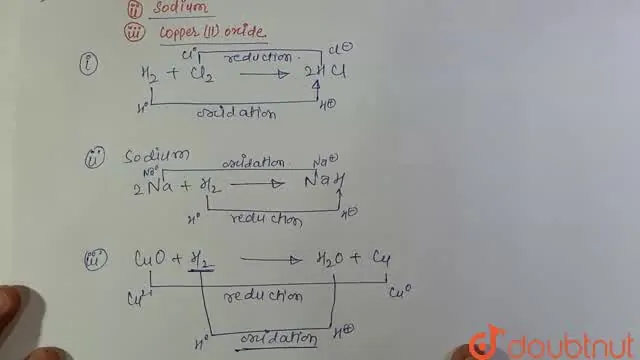Comment upon the reactions of dihydrogen with
(i) Chlorine
(ii) Sodium and
(iii) Copper (II) oxide
(i) Dihydrogen reduces chlorine to Cl− ion and itself gets oxidised to H+ ions. An electron pair is then shared between these two species to form a covalent melecules of hydrogen chloride.
H2(g)+Cl2(g)→2HCl(g)
(ii) Sodium reduces dihydrogen to form hydride ion (H−) and itself gets oxidised to sodium ion (Na+) During this reaction, an electron is completely transferred from Na to H thereby ionic sodium hydride, Na+H−
2Na(s)+H2(g)Δ−−→2Na+H−(s)
(iii) Hydrogen reduces copper (II) oxide to copper metal. (zero oxidation state) while itself gets oxidized to form a covalent moleule of H2O (in which H has an oxidation state of +1).
+2−2CuO(s)+0H2(g)→0Cu(s)++1H2−2O(l)
Related Playlists
- BOOK - PRADEEPCHAPTER - HYDROGEN EXERCISE - NCERT Questions and Exercises with Answers (NCERT Exercises)1videos
HYDROGEN
- BOOK - PRADEEPCHAPTER - HYDROGEN EXERCISE - NCERT EXEMPLAR PROBLEMS WITH ANSWER, HINTS AND SOLUTIONS (NCERT Exemplar Problems Chapter 9 Hydrogen) Multiple Choice Question-I18videos
HYDROGEN
- BOOK - PRADEEPCHAPTER - HYDROGEN EXERCISE - CONCEPTUAL QUESTIONS (Water)7videos
HYDROGEN
- BOOK - PRADEEPCHAPTER - HYDROCARBONSEXERCISE - Competition Focus (JEE(main and advanced)/Medical Entrance) VIII. ASSERTION - REASON TYPE QUESTIONS31videos
HYDROCARBONS
- BOOK - PRADEEPCHAPTER - ORGANIC CHEMISTRY-SOME BASIC PRINCIPLES TECHNIQUESEXERCISE - Competition Focus (Jee (Main and Advanced)/Medical Entrance) VIII. Assertion-Reason Type Questions25videos
ORGANIC CHEMISTRY-SOME BASIC PRINCIPLES TECHNIQUES
Similar Questions
Comment upon the reactions of dihydrogen with
(i) Chlorine
(ii) Sodium and
(iii) Copper (II) oxideView SolutionComment on the reaction of dihydrogen with fluorine.
View SolutionCommet on the reactions of dihydrogen with (a) chlorine,(b) sodium and (c) copper (II) oxide.
View SolutionComment on the reaction dihydrogen with fluorine.
View SolutionWrite chemical equations for the reactions of ethanoic acid with:
(i) sodium, (ii) sodium carbonate.
(iii) ethanol in the presence for conc. H2SO4.View SolutionWrite the balance chemical equations for the following chemical reactions :
(i) Hydrogen + Chlorine → Hydrogen chloride.
(ii) Lead + Copper chloride → Lead chloride + Copper
(iii) Zinc oxide + Carbon → Zinc + Carbon monoxide.View SolutionGive the nature of bonding in the following solids :
(i) ice (ii) iodine (iii) copper (iv) calcium oxide.View SolutionIn the reaction between sodium and chlorine to form sodium chlorine
View SolutionFind: (i) 6412 (ii) 3215 (iii) 12513
View SolutionWrite the balanced chemical equations for the following reactions :
(i) Manganese dioxide and concentrated hydrochloric acid.
(ii) Sodium thiosulphate and iodine.
(iii) Copper and dilute nitric acid.
(iv) Sulphur dioxide and hydrogen sulphide.View Solution


